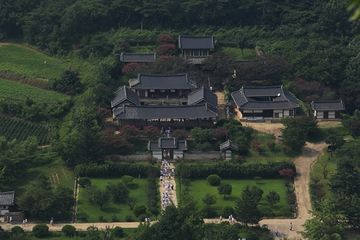안동 병산서원
| 안동 병산서원 Byeongsanseowon Confucian Academy, Andong |
|
 안동 병산서원, 국가문화유산포털, 문화재청. |
|
| 대표명칭 | 안동 병산서원 |
|---|---|
| 영문명칭 | Byeongsanseowon Confucian Academy, Andong |
| 한자 | 安東 屛山書院 |
| 주소 | 경상북도 안동시 풍천면 병산리 30번지 |
| 지정(등록) 종목 | 사적 제260호 |
| 지정(등록)일 | 1978년 3월 31일 |
| 분류 | 유적건조물/교육문화/교육기관/서원 |
| 시대 | 조선시대 |
| 수량/면적 | 27,251㎡ |
| 웹사이트 | 안동 병산서원, 국가문화유산포털, 문화재청. |
|
|
|
해설문
국문
서원은 조선시대에 세워진 사립 교육기관으로, 선현 제향과 교육의 기능을 수행하였다.
병산서원은 조선시대의 재상이자 학자였던 서애 류성룡(西厓 柳成龍, 1542~1607)을 기리고 후학을 양성하기 위해 1614년에 세운 서원이다. 류성룡은 이황(李滉, 1501~1570)의 제자로, 문과에 급제한 뒤 중요한 관직을 두루 거쳤다. 특히 임진왜란 당시 이순신(李舜臣, 1545~1598)을 추천하여 전쟁에 대비한 것으로 유명하다. 전란 중에 영의정에 제수되어 국가의 위기를 극복하는 데 온 힘을 기울였다.
류성룡은 풍산에 있던 풍악서당을 1572년 현재 병산서원의 위치로 옮기고 문중 자손들을 위한 교육시설로 사용하였다. 이후 1614년 제자들과 지역의 유림이 서당에 존덕사(尊德祠)를 세우고 류성룡의 위패를 모시면서 서원으로 재탄생하였으며, 1662년에는 류성룡의 셋째 아들이자 그의 학문을 계승한 류진(柳袗, 1582~1635)을 추가로 제향하였다. 1863년 철종(1849~1863 재위)이 병산서원이라는 이름을 내려주었는데, ‘병산’은 자연경관이 병풍을 둘러치듯 아름답다고 하여 불린 이름이다. 1868년 서원을 모두 철폐하라는 명이 내려졌을 때도 국가의 존중을 받아 철폐되지 않은 47개 서원 가운데 하나였다.
경내에는 입교당을 비롯한 강학영역을 앞에 배치하고 존덕사를 비롯한 제향영역을 뒤에 배치하였다. 이 외에 휴식 공간인 만대루와 문서와 유물을 보관하는 장판각, 제기와 제구를 보관하는 전사청, 서원을 관리하던 노복들의 거처공간인 고직사 등의 건물이 있다. 병산서원은 서원이 번성하던 시기의 한 본보기로 여겨질 만큼 지은 솜씨가 빼어나고 보존이 잘 되어 있으며, 주변의 아름다운 자연과 조화를 이루도록 지은 점에서 ‘한국 서원 건축의 백미’로 이름나 있다.
2019년 7월 “한국의 서원”이라는 이름으로 다른 8곳의 서원과 함께 유네스코 세계문화유산에 등재되었다.
영문
Byeongsanseowon Confucian Academy, Andong
Confucian academies, called seowon in Korean, are private education institutions of the Joseon period (1392-1910) which usually combined the functions of a Confucian shrine and a lecture hall.
Byeongsanseowon was established in 1614 to honor Ryu Seong-ryong (1542-1607), a renowned statesman and eminent Confucian scholar of the Joseon period. Ruy was a student of Yi Hwang (1501-1570, pen name: Toegye), one of the greatest Confucian scholars of the Joseon period, and he served as chief state councilor during the Japanese invasions of 1592-1598.
In Ruy Seong-yong’s record of service it is significant that he recommended Yi Sunshin (1545~1598) to the court as a military leader to combat the Japanese invasion of Korea in 1592. Ryu’s leadership as Right Chief Councillor also helped overcome this national crisis.
The Byeongsan Seodang School established by Ryu was moved from Pungsan in 1572 to its present location where young men from the Ryu Clan were educated. After Ryu Seong-jong died in 1614 his students and local Confucians built the Jondeksa Shrine to commemorate him and the seodang was upgraded to a Seowon (Academy). The name of this seowon, Byeongsan, was given by King Cheoljong (r. 1849-1863) in 1863 and means, ‘a beautiful landscape screen’. The academy survived the national decree of demolition of seowon along with 47 other academies.
In front of the academy is a learning center that consists of Ipgyodang Hall and ritual buildings, with the Jondeoksa Shrine behind. In addition, the attached buildings are Mandaeru for rest, Jangpangak storage, Jeonsacheong storage of ritual dishes, and Gojiksa for staff residence. This academy is representative of a seowon built to be in harmony with nature.
Along with eight other Seowon , Dosanseowon was designated under the name ‘Seowon, Korean Neo-Confucian Academies’ as a World Cultural Heritage site in 2019.
문맥요소
Nodes
| ID | Class | Label | Description |
|---|---|---|---|
| 유성룡 | 인물 | 유성룡 | 1542~1607 |
| 유진 | 인물 | 유진 | 1582~1635 |
| 존덕사 | 장소 | 존덕사 | |
| 입교당 | 장소 | 입교당 | |
| 만대루 | 장소 | 만대루 | |
| 장판각 | 장소 | 장판각 | |
| 전사청 | 장소 | 전사청 | |
| 고직사 | 장소 | 고직사 | |
| 세계문화유산 | 개념 | 세계문화유산 |